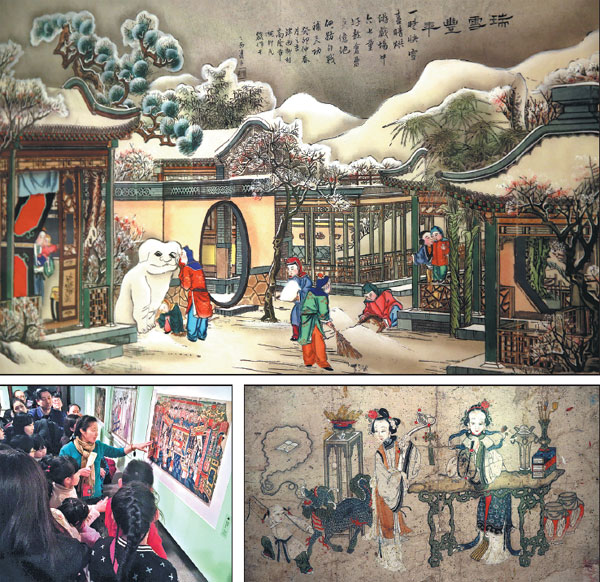Lunar new year art shines
By Lin Qi (China Daily) Updated: 2017-02-14 07:16An exhibition about nianhua art at the National Art Museum of China traces the history of the traditional New Year paintings. Lin Qi reports.
When it comes nianhua, the traditional New Year paintings that the Chinese hang on walls and doors to seek blessings, many tend to portray a chubby child holding a big fish.
This is done to express the wish for the family line to thrive and prosper.
But one finds other objects paired with children in the nianhua if one visits Spring Breeze from Yangliuqing, an exhibition about nianhua art at the National Art Museum of China.
The Beijing museum is showing some 140 paintings.
They were produced in the town of Yangliuqing, a nianhua production center in Tianjin, during the Qing Dynasty (1644-1911) and early Republic of China period (1911-49).
The paintings were mostly donated by Wang Shucun (1923-2009), a folk art historian and Yangliuqing native.
Many are the only prints of their kind in existence, making the exhibition a rare chance for viewers to understand the aesthetics of their ancestors, according to Wu Weishan, the director of the National Art Museum of China.
The works portray little children posing with a variety of objects: A baby boy sits between lotus flowers and lotus seed pods that suggest fertility; two children raise a lotus lamp and hold two lion cubs implying hope for career success; and four children hold vases of flowers that bloom in different seasons conveying a wish for a peaceful year.
Bo Songnian, a retired professor of art history at Beijing's Central Academy of Fine Arts, says such paintings were well received because the Chinese value the carrying on of the family line and reflect their ambitions for their offspring.
He adds that similar motifs also appear in other forms of art such as ceramic pillars of the Song Dynasty (960-1279).
In the old days, several nianhua painters thrived on painting children although they did not become household names.
For instance, Song painter Liu Zongdao could sell several hundred works a day. Another painter Song Hai'er, whose real name is not known, is remembered as "the man surnamed Song and specializing in painting children".
Yangliuqing, which means green willows in Chinese, got its name for the lush trees. It was also hailed as xiao su hang - a miniature version of southern China's beautiful Suzhou and Hangzhou cities - in northern China.
It is recorded that the production of New Year paintings began there in the mid-Ming Dynasty (1368-1644) and reached its peak in the mid-Qing Dynasty.
Bo says that the nianhua art form in Yangliuqing boomed because it was an important port, especially for shipping grain through the Grand Canal, which connected Beijing and Hangzhou.
Economic prosperity also led to local residents becoming more open-minded and seeking refined artistic products, he adds.
It is said that in its "golden years", there were more than 3,000 nianhua artists in Yangliuqing and almost every household in its neighboring 36 villages could produce nianhua paintings.
Merchants from southern China also brought to Yangliuqing their own artistic styles, which were infused into the northern culture.
But Bo says: "Older painters still followed some rules that had been passed down since the Song Dynasty.
"For example, in the paintings a woman's shoulder would not be highlighted so that she looked slender, and a Buddhist figure would be portrayed elegantly. Also, when fairies were portrayed, only a few colors were used."
Wu says that paintings done during the reigns of the Qing emperors Kangxi and Qianlong have a simple composition because painters then paid a lot of attention to facial expressions.
He adds, however, that during the reigns of later emperors, painters had more figures in a scene and the colors and compositions were more diverse.
Also, besides children, nianhua painters also painted a lot of menshen, or door gods who people believed would fight evil spirits and bad luck.
The nianhua works also touched on educational themes.
So, when a lot of people fell victim to opium addiction in the 1880s, some studios did works that urged people to quit drinking, gambling and opium.
Contact the writer at linqi@chinadaily.com.cn
If you go
9 am-5 pm, closed on Mondays, through March 26. 1 Wusi Dajie, Dongcheng district, Beijing. 010-6400-1476.
|
An ongoing exhibition about nianhua, the traditional Chinese New Year paintings, shows 140 vintage pieces that were produced in Tianjin's Yangliuqing town and reviews various subjects and styles that prompted Yangliuqing to become a nianhuaproduction center. Photos By Jiang Dong / China Daily |
- 'Cooperation is complementary'
- Worldwide manhunt nets 50th fugitive
- China-Japan meet seeks cooperation
- Agency ensuring natural gas supply
- Global manhunt sees China catch its 50th fugitive
- Call for 'Red Boat Spirit' a noble goal, official says
- China 'open to world' of foreign talent
- Free trade studies agreed on as Li meets with Canadian PM Trudeau
- Emojis on austerity rules from top anti-graft authority go viral
- Xi: All aboard internet express












